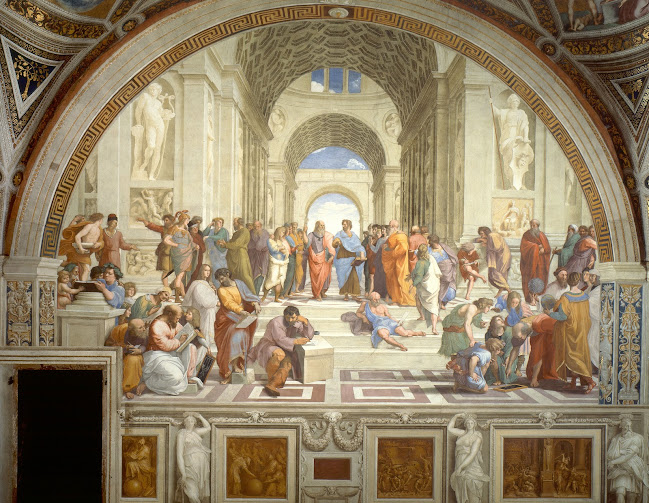Meet the Intellects in 'The School of Athens' by Raphael
Painting: 'The School of Athens' by Raphael
Influential figures in this painting:
Plato
Plato's symbolic gesture of pointing up to the sky resembles his idea of "Theory of Forms" in which he explains that our world, the physical realm, is not real, but rather so the spiritual realm is the truth. Spirituality is where our ultimate reality lies, not in this materialistic world.
Aristotle
Aristotle places his hand forwards, facing it towards the ground, to symbolize his theory of empiricism. This theory explains that all knowledge comes from sensory experience—smell, touch, sight, taste, and vision. Although Plato and Aristotle are right next to each other, their theories somewhat differ as Aristotle proposed a very humanistic approach to the concept of epistemology—the theory of knowledge.
Socrates
He is considered the father of philosophy and has taught many including both Plato and Aristotle. Socrates would enlighten people by questioning them endlessly as he believed that the answers to our most fascinating questions lie within ourselves. As a lover of the intimacy of conversations, never has he written anything in his life, all of his teachings reach us through the writing of Plato on Socrates in his books like Plato's Republic.
Euclid
Euclid, specifically Euclid of Alexandria, was a Greco-Roman mathematician. He made the groundbreaking discovery of “Euclidean geometry” which is the study of both plane and solid figures based on theorems and axioms. This led him to the honorable title of the “father of geometry”. His concrete theorems and practicality represented Aristotle’s beliefs, which is why he is positioned on the right side of the painting.
Ptolemy
Through intense observation and mathematical reasoning, this astronomer and mathematician developed a geocentric theory of the Earth, stating that the Earth is the center of the universe with the Sun, Moon, and other planets circling around it. This theory is the reason he is holding a terrestrial globe in the painting. His work, although discredited, left an impact on the way astronomers study planetary positions.
Alcibiades
A student of Socrates (standing in front of Socrates) and Athenian statesman who is known for his flair for the dramatic and courage in battle, especially during the Peloponnesian War between Athens and Sparta.
Aeschines of Sphettus
A follower of Socrates (also standing in front of Socrates).
Pythagoras
Pythagoras has a significant amount of scientific and mathematical discoveries as he has made large contributions to the field of geometry with ideas such as the Pythagorean Theorem. He not only developed many mathematical ideas, but he proposed the sphericity of planets, promoted his belief in metempsychosis—transmigration of the soul after death (cause for his position on Plato’s side), numerology, and music theories.
Zoroaster
An ancient Iranian prophet who founded the religion of Zoroastrianism.
Raphael
Raphael was the Rennaisance artist who created this painting. Back then, it was said to be a bold move to include a self-portrait amongst these highly intellectual people.
Diogenes
He was said to be the founder of Cynicism which was a philosophical school of thought that promoted leading a life free of all material possessions. Critical of many of his peer philosophers like Plato, he was seen to be a controversial figure during this time.
Heraclitus
The Greek philosopher, Heraclitus, applied many of his ideas to the study of cosmology. His ideas include: all things are ever-changing, unity in opposition, and the universe as an everlasting fire living in harmony with the concept of Logos—logical reasoning.
Anaximander
As a pupil of Thales, Anaximander did not only excel in the area of cosmology where he proposed ideas like the possible cylindrical shape of Earth and all life originating from water, but he was one of the first to ask “from where did the universe originate” philosophically.
Plotinus
After the influence of Plato's readings, Plotinus founded Neoplatonic philosophy that promotes the idea of all souls reuniting with the soul of the higher being from which they emerged.
Sodoma
Sodoma, or in other words, Giovanni Antonio Bazzi, was an influential painter during the Renaissance Era.
Parmenides was titled the founder of ontology—the science of being, which is considered a subcategory of metaphysics. He considered change as a mere illusion, since all things despite their ever so altering appearances, still have the essence of the Being.

Comments
Post a Comment